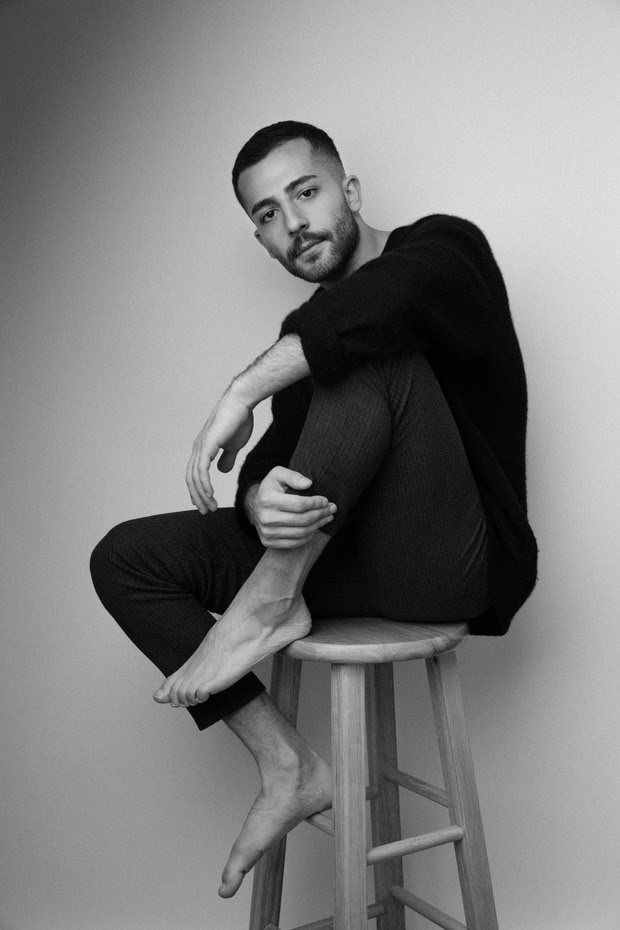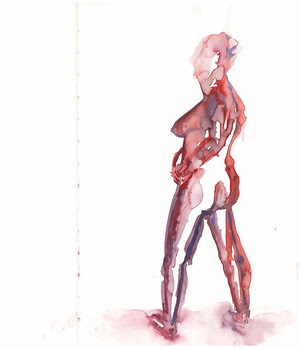 #1.
#1.
German born artist Damun Jawanrudi has been a multifaceted painter since the age of five when he first picked up the paint brush while a student at art school. Raised in Cologne, Germany – a child of political refugees who emigrated from Iran, Jawanrudi’s works span landscape paintings, sketches, and vibrant abstract works full of depth and color. Firstly influenced by Jackson Pollock, Caspar David Friedrich, Gerhard Richter, and later by Egon Schiele and Gustav Klimt, Jawanrudi’s works often reference these great masters for their intensity. While studying architecture in Germany, Jawanrudi took an interest in life drawing, line drawing, and ink and charcoal work, and also began exploring with form and figure, as well as contour drawing. After graduating with a degree in Architecture, Jawanrudi took a position with the Swiss firm Herzog & de Meuron in Hamburg to work on the construction of the Elbe Philharmonic Hall, yet continued to pursue painting and immerse himself deeply with life drawings. Following his career goals, Jawanrudi moved to New York City and immersed himself within the New York art scene and regularly frequented galleries in the Lower East Side and Soho. His paintings also began to take on a broader and larger scale as he began to paint on large canvas, which have lead to his first series of large-scale paintings, titled #1-#6.2. These works represent an emergence out of love and its following heartbreak, particularly because they began when the artist fell in love while living in New York. Through the use of colors on top of each other, Jawanrudi explores the depth of love and the result of wreckage in heartbreak. His paintings have consistently allowed him a peace, healing and closeness to himself that emanates and is palpably present to the viewer. His works represent the most meaningful expression of the importance and significance of the emotional process rather than a exclusively visually appealing final product. Each of the pieces within the series provoke and incite a deep and subconscious response from the viewer; yet, the artist maintains that such response, although written within the canvas itself, is solely the ownership of the viewer, and can always be something entirely different for every viewer. The artist makes this cunningly possible because within his works he opens the door for the viewer to enter the work, response instinctively and honestly as it relates to him or her, and delve deeper by deciphering meaning and an emotional depiction within the work that is a rendering of the viewer’s reaction.

Photo courtesy of ©Alejandro Ibarra.
Exclusive interview with Damun Jawanrudi
What is your background?
 #5.
#5.  #3.
#3.
What inspires you?
– kitschy but true: moments of deep silence and self-reflection
– feelings (good or bad)
– colors
– spontaneity and cluelessness when starting a work
– chaos in an order (for example if I splash color and create texture on top of an evenly painted canvas) and order in chaos (for example if have random movements on a canvas, but if you take a step back and look at the entire work you see a certain order of aesthetics)
– movement, rhythm and sound (of the brush or of music for example, I always listen to music when I paint), concentration/ focus, (technique)
Favorite quote that describes me and my work?
– I don’t have one, I try to not quote. These days quotes have lost their magic to me, since they are being misused everywhere and by anyone. We should start quoting ourselves.
 #1.
#1. 
What does art and fashion mean to you?
– Big question, very big question. I will try to sum up and bring to one point: This very much depends on my perception of art and fashion vs. how each individual reader defines art and fashion in their head while reading this response. In my eyes, art and fashion are both tools, a language that can communicate with us. This communication completely and solely depends on two things – 1. Who is the person that is talking? 2. Who is the person that is listening? There is so much art or fashion in this world that I cannot relate to or does not provoke anything within me. On the other hand the same things could be fascinating to someone else. And I think this is the main beauty of it – there is no wrong or right, it is not
based on a logical rule, it is something spiritual, emotional and natural. If I communicate, I feel, it can be good, it can be bad, but something moves within me. So to answer the questions – art and fashion as tools of communication mean a lot to me, I use them, I enjoy others using them.
What meaning toes this particular editorial have? Does it have a specific point to make?
– This publication means a lot to me, since it is the first time that I am opening up to the public with my paintings and the story behind it, which is something very intimate to me. I already gained everything that I wanted from my paintings and the painting itself, which is mainly getting closer to understanding myself and with that feeling better and aware. So I am not really pursuing this for any type of fame/ or money. However, I am very interested what others see when they look at my paintings and what that does to me. Of course, I am more than interested in connecting further and being introduced to opportunities to further explore.
You also have another career in Architecture. How would you say art and architecture relate and/ or
differ from each other?
– I would say that my work in architecture represents my personality for someone else, while art represents my personality without a purpose. That’s why it can be blue, black, green or yellow – there is no one on the other end that my work is addressed to, or my work is addressed to everybody. Of course architecture and art can overlap or can be the same. But I don’t think that a good architect equals a good artist automatically or the other way around. Both, art and architecture share a lot of attributes, but I think can be separated pretty well when knowing the backgrounds of the work. During my work as a designer I feel close to “reality”. During my work as an artist I feel in a parallel world, somewhere far from here.
Why did you choose architecture as the career path and not focus solely as an artist?
– Simply, because I have certain interests, like music, fashion, cooking or psychology that I do not want my rent to depend on. I don’t want to be pressured in any type of way when something is very personal or intimate to me. Architecture, however is still a passion of mine – but it is a passion that I am willing to share with everyone. There might be paintings or work of mine as an artist that I would not want to share. I chose architecture, knowing that I can still do whatever I want in life, if that is art or anything else.
Who/ what inspires you the most in fashion and art? Anyone who stands out?
– I really, really do feel good when I look at work from Gerhard Richter. Also I feel a certain closeness, since he lives and works in my hometown. Artist’s work of Egon Schiele or Klimt also make me feel like I can hear what they are saying. They touch me personally, especially the ones that represent love or loneliness. Currently in fashion I am mostly inspired by old Japanese movies with their kimonos and their well done hair and old black and white movies in their perfect suites, hats and shoes. No one specifically stands out to me.

 #Mann und Stuhl, charcoal
#Mann und Stuhl, charcoal
What do you see as your signature artistic style?
– I would not want to think of myself as someone who has a signature style, because I think that it would limit myself when I am painting. Nonetheless I do not doubt that there might be similar aspects or techniques in my work. At the same time I do not know how temporary that is and if very soon something inspires me in a way that I “lose” my signature style. Up until now I can say though that my signature style is not in a visual way, my signature style could just be that I really paint with passion and heart. If I have painted it, you can be sure that I really have an honest connection to it. There are no lies in my work!
What is next for you?
– Next for me is to take some time off, a couple of months. And then to just fill this time with everything that brings me joy and with everything with what I can help others. I am planning to rent a small cabin in the woods or the mountains somewhere and isolate myself and paint (or not), travel to places I have missed to travel to in the past years (parts of Africa and Asia). Also I have applied for a volunteering program in Nepal where I can help building schools for the people there. The list of my “nexts” is endless, but these are the next couple of months.

